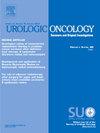肌肉浸润性膀胱癌患者接受确定治疗与非确定治疗的结果和医疗资源利用:退伍军人事务系统中的现实世界分析
IF 2.4
3区 医学
Q3 ONCOLOGY
Urologic Oncology-seminars and Original Investigations
Pub Date : 2025-03-01
DOI:10.1016/j.urolonc.2024.12.036
引用次数: 0
摘要
大约25%的膀胱癌患者(pts)被诊断为肌肉侵袭性疾病(MIBC)。目前针对MIBC的明确治疗(DT)包括根治性膀胱切除术(RC)和放化疗(CR)。尽管在指南中有明确的生存益处和强烈推荐DT,但大约50%的MIBC患者只接受非确定性治疗(NDT)。接受无损检测的MIBC患者的自然历史和结果没有得到充分的描述。我们分析了现实世界的数据,通过评估他们的人口统计学和临床特征、生存、治疗模式、卫生保健资源利用(HCRU)和相关成本,更好地表征接受NDT的MIBC患者,并将其与在美国退伍军人事务部(VA)平等获取的卫生保健系统中接受DT的患者进行比较。方法通过自然语言处理模型和补充图表回顾对2010-2019年VA系统中诊断为MIBC的患者进行识别,并将其分为DT组(RC或CR)和NDT组。通过综合试验总结和比较基线特征。总生存期(OS)通过未校正Kaplan-Meier图可视化,并通过log-rank检验进行比较。具有时间相关协变量的多变量Cox比例风险模型检验了治疗组对OS和膀胱癌特异性死亡率(BCSM)的影响,并根据基线特征进行了调整。在分析BCSM时,相互竞争的风险模型考虑了其他原因造成的死亡。全因HCRU和相关费用以每年人均(PPPY)为基础进行总结,并通过综合试验评估治疗组之间的差异。结果我们确定了1524例MIBC患者:650例接受了NDT, 740例接受了RC, 134例接受了CR。NDT患者在MIBC诊断时年龄较大(中位数:77[NDT], 68[RC], 73[CR]岁;p<0.001),且Charlson合并症指数评分较高(平均值:1.9[NDT], 1.3[RC], 1.7[CR];术中,0.001)。不同治疗组的社会经济地位没有差异。在未经校正的Kaplan-Meier图(log-rank p<0.001)和Cox模型(校正风险比(HR): 0.49[RC], 0.65[CR];两者,p<0.001)(图1)。此外,接受DT治疗的患者比接受NDT治疗的患者BCSM更低(调整后的HR: 0.45[RC], 0.57[CR];两个术;0.001)。在全因HCRU和费用中,RC的住院费用最高,CR的门诊费用最高,NDT的急诊室(ER)就诊次数最高(表1;所有术;0.001)。结论:这一现实世界的分析表明,与接受DT治疗的患者相比,接受NDT治疗的MIBC患者年龄更大,合并症更多,社会经济地位相似,生存率更差。尽管NDT的住院和门诊费用低于DT,但NDT患者的总体住院和门诊费用仍然很高,尽管他们没有接受指南推荐的治疗。大量的急诊室就诊进一步增加了NDT患者的负担。虽然我们测量了HCRU和相关成本,但需要进一步的研究来评估DT和NDT对患者的其他影响,包括生产寿命年的损失,以及患者和照顾者的身体和情感负担,特别是对于NDT患者,后者尚未得到很好的研究。综上所述,这些发现突出了接受无损检测的MIBC患者的需求未得到满足,需要新颖、更有效的保膀胱治疗。本文章由计算机程序翻译,如有差异,请以英文原文为准。
OUTCOMES AND HEALTHCARE RESOURCE UTILIZATION OF PATIENTS RECEIVING DEFINITIVE VERSUS NON-DEFINITIVE TREATMENT FOR MUSCLE-INVASIVE BLADDER CANCER: A REAL-WORLD ANALYSIS WITHIN THE VETERANS AFFAIRS SYSTEM
Introduction
Approximately 25% of bladder cancer patients (pts) are diagnosed with muscle-invasive disease (MIBC). Current definitive treatments (DT) for MIBC with curative intent include radical cystectomy (RC) and chemoradiation (CR). Despite established survival benefits and strong recommendations for DT in guidelines, approximately 50% of MIBC pts only receive non-definitive treatments (NDT). The natural histories and outcomes of MIBC pts receiving NDT are insufficiently described. We analyzed real-world data to better characterize MIBC pts undergoing NDT by evaluating their demographic and clinical characteristics, survival, treatment patterns, health care resource utilization (HCRU) and associated costs, and compare them to pts receiving DT within the context of an equal-access health care system, the US Department of Veterans Affairs (VA).
Methods
Pts diagnosed with MIBC within VA system from 2010-2019 were identified by a natural language processing model and supplementary chart review, then categorized into one of two DT groups (RC or CR) or the NDT group. Baseline characteristics were summarized and compared by omnibus tests. Overall survival (OS) was visualized by the unadjusted Kaplan-Meier plot and compared by the log-rank test. Multivariable Cox proportional hazard models with time-dependent covariates tested the impact of treatment groups on OS and bladder cancer-specific mortality (BCSM), adjusting for baseline characteristics. Competing risk models accounted for death from other causes when analyzing BCSM. All-cause HCRU and associated costs were summarized on a per-pt per-year (PPPY) basis, and differences across treatment groups were assessed by omnibus tests.
Results
We identified 1,524 pts with MIBC: 650 received NDT, 740 received RC, and 134 received CR. NDT pts were older at MIBC diagnosis (median: 77[NDT], 68[RC], 73[CR] years; p<0.001) and had higher Charlson Comorbidity Index scores (mean: 1.9[NDT], 1.3[RC], 1.7[CR]; p<0.001). No difference was found for socioeconomic status among treatments. An OS advantage was observed for pts receiving DT vs NDT in both the unadjusted Kaplan-Meier plot (log-rank p<0.001) and the Cox model (adjusted hazard ratios (HR): 0.49[RC], 0.65[CR]; both, p<0.001) (Figure 1). Additionally, pts receiving DT had lower BCSM compared to those receiving NDT (adjusted HR: 0.45[RC], 0.57[CR]; both, p<0.001). In all-cause HCRU and costs, inpatient costs were highest for RC, outpatient costs were highest for CR, and the number of emergency room (ER) visits was highest for NDT (Table 1; all, p<0.001).
Conclusions
This real-world analysis in a large equal-access health care setting suggests that pts with MIBC receiving NDT were older, had more comorbidities, similar socioeconomic status, and worse survival compared to pts receiving DT. Although NDT was associated with lower inpatient and outpatient costs than DT, the overall inpatient and outpatient costs for NDT pts remain substantial despite not receiving guideline-recommended treatment. High number of ER visits further increases the burden of NDT pts. Although we measured HCRU and associated costs, further studies are needed to evaluate other impacts of DT and NDT on pts including productive life-years lost, and the physical and emotional burden on pts and caregivers, especially for NDT pts as the latter have not been well studied. Taken together, these findings highlight unmet needs among MIBC pts receiving NDT where novel, more efficacious bladder-sparing treatments are required.
求助全文
通过发布文献求助,成功后即可免费获取论文全文。
去求助
来源期刊
CiteScore
4.80
自引率
3.70%
发文量
297
审稿时长
7.6 weeks
期刊介绍:
Urologic Oncology: Seminars and Original Investigations is the official journal of the Society of Urologic Oncology. The journal publishes practical, timely, and relevant clinical and basic science research articles which address any aspect of urologic oncology. Each issue comprises original research, news and topics, survey articles providing short commentaries on other important articles in the urologic oncology literature, and reviews including an in-depth Seminar examining a specific clinical dilemma. The journal periodically publishes supplement issues devoted to areas of current interest to the urologic oncology community. Articles published are of interest to researchers and the clinicians involved in the practice of urologic oncology including urologists, oncologists, and radiologists.

 求助内容:
求助内容: 应助结果提醒方式:
应助结果提醒方式:


